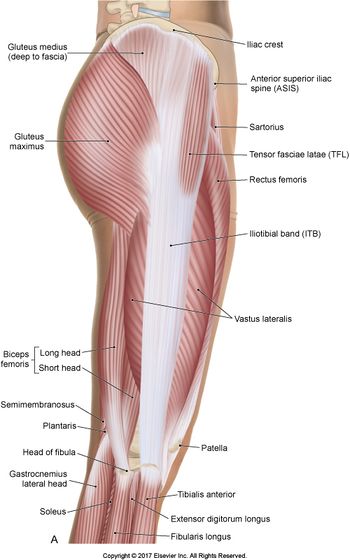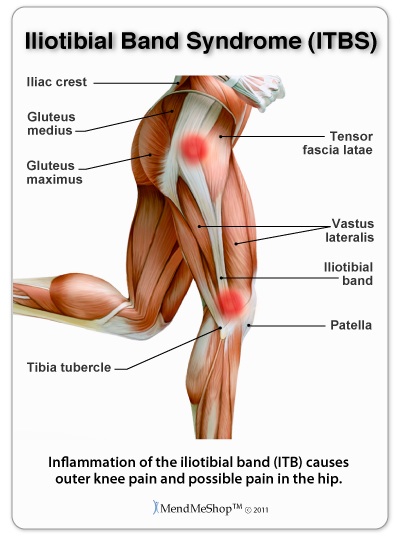Which of the Following Muscles Pulls on the Iliotibial Tract
Iliotibial bursitis is inflammation of the bursa on the outside of the knee. 121 The muscle that inserts on the iliotibial tract and gluteal tuberosity of the femur is the A tensor fasciae latae.
Its possible that you just happened to be born with a tighter iliotibial band.

. The band works with your thigh muscles to provide stability to the outside of the knee during movement. The IT tract receives contributions from the tensor fascia lata TFL and gluteus maximus muscles in the proximal thigh and in- sertsdistallyabouttheknee includingonto theproximaltibia Fig. The tensor fasciae latae TFL is a muscle of the proximal anterolateral thigh that lies between the superficial and deep fibers of the iliotibial IT band.
Which of the following muscles pulls on the iliotibial tract. And what boney landmark is this. Pectineus gluteus maximus gluteus medius vastus medialis all of the above.
The band of collagen fibers that laterally braces the knee is the. The IT band stabilizes the knee both in extension and in partial flexion and is therefore used constantly during walking and running. It is innervated by the inferior gluteal nerve.
While bluntly separating the iliotibial tract from adja-cent muscles and the fascia lata particular attention was devoted to preserve the course of fiber direction. The other leg can be crossed in front of you. Preexisting iliotibial band tightness.
A Components used in the. Biceps femoris semimembranosus semitendinosus all of the above. A gluteus medius biceps femoris B tensor fascia latae biceps femoris c vastus lateralis gluteus maximus D tensor fascia latae adductor longus E tensor fascia latae gluteus maximus 99 Which of the following is true.
Superior gluteal nerve action. The iliotibial bursa is located beneath a long tendon iliotibial band that connects muscles of the buttock. The gluteus maximus muscle and the tensor fasciae latae insert upon the tract.
Put as much of your weight as you can stand onto your bottom leg. Lab 2- muscles of. What muscle originates here.
Muscles that laterally rotate the thigh include all of the following except the. It also allows the tensor fascia latae and gluteus maximus muscles to support the extension of the knee while standing walking running and biking. There is high variability in muscle belly length although in most patients the TFL muscle belly ends before the greater trochanter of the femur.
When a person is leaning forwards with a slightly flexed knee the tract is the knees main support against gravity. The iliotibial band ITB IT Band or iliotibial tract is a reinforced band of dense fibrous connective tissue fascia in the thigh connecting proximally to the Tensor Fascia Lata and Gluteus Maximus muscles and distally to the lateral condyle of the tibia Gerdys Tubercle. Sets found in the same folder.
Which of the following muscles pulls on the iliotibial tract. It is an elastic group of fibers that runs along the thigh from the hip to below. To perform this exercise do the following steps.
And what boney landmark is this. Which of the following muscles pulls on the iliotibial tract. A bursa is a fluid-filled sac that is often found near a joint.
It attaches on the outside of the shin bone or tibia just below the knee joint. Functionally the iliotibial tract extends the tensor fascia latae muscle into the lower thigh and leg allowing it to function as an abductor medial rotator and flexor of the thigh. Bursas act as cushions to help tendons glide smoothly over bony surfaces during joint movement.
Flexes abducts and medially rotates the hip joint. A gluteus maximus B gluteus medius C vastus medialis D pectineus E both A and C. Joins iliotibial tract long fascia lata tendon just below the hip which runs to the upper lateral side of the tibia.
Outer edge of iliac crest towards the front. Iliacus and psoas major iliopsoas insertion. This muscle lies anterior to gluteus maximus on the lateral side of the hip.
The gluteus maximus is the main extensor muscle of the hip and is considered one of the strongest muscles in the human body. It was precisely traced to detect insertion points and connectivi-ties to adjacent myofascial structures. Which of the following pair of muscles have their insertion on the iliotibial tract.
Along with the gluteus maximus the tensor fascia lata muscle forms the iliotibial tract. Hip abduction and medial rotation of thigh. Which of the following is a member of the hamstring group.
It is connected to the coccyx and other surrounding bones. Gluteus maximus pectineus gluteus medius vastus medialis All of the answers are correct. The IT band is made up of fascia or connective tissue.
What muscle inserts here. Analogously the fibularis muscles were dissected without removing or. This exercise has an average time of 110 a best time of 210 and has been logged 7 times in the last year.
The large and strong gluteus maximus gluteus medius and gluteus minimus extend and abduct the femur. The iliotibial IT band is a strong thick band of fibrous tissue that starts at the hip and runs along the outer thigh. Lie on your side with your bottom leg on a foam roller between your hip and knee.
Your tight iliotibial band might rub against your bones for reasons that include. Genu varum causes your knees to spread when your feet touch your ankles. Which of the following muscles pulls on the iliotibial tract.
Muscles that laterally rotate the thigh include all of the following except the. It also inserts into the iliotibial tract. The TFL works in conjunction with the gluteus maximus gluteus.
The muscle that inserts on the iliotibial tract and gluteal tuberosity of the femur is the. This pulls on your iliotibial band tightening it. -Which of the following muscles pulls on the iliotibial tract.

Body Of Knowledge Anatomy Of The It Band Also Known As The Iliotibial Tract The It Band Is A Multipurpose Tendon That Runs Down The Length Of The Outer

The Iliotibial Band Full Circle School Of Massage Therapyfull Circle School Of Massage Therapy


No comments for "Which of the Following Muscles Pulls on the Iliotibial Tract"
Post a Comment